Compressed breathing air systems are a must for people working in or exploring environments that lack clean air; firefighters, SCUBA divers, and HAZMAT teams are some examples of people who use breathing air systems to do their jobs safely. Arctic Compressor’s complete breathing air systems guide is here to help you understand the fundamentals!
Breathing air compression systems typically consist of three major components: the compressor, the storage cylinders, and the fill station.
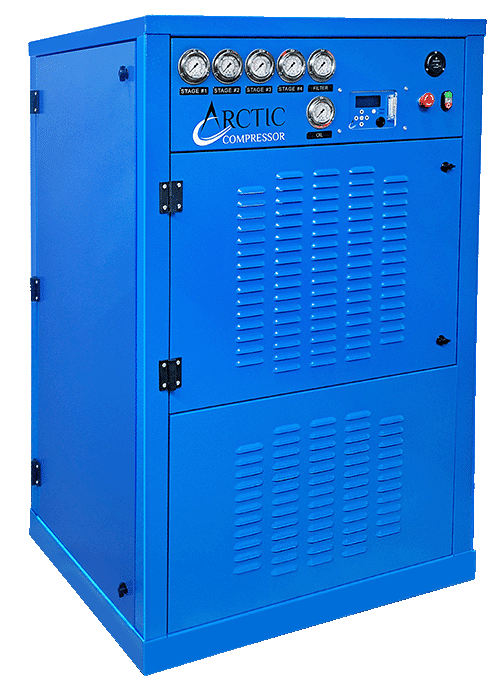
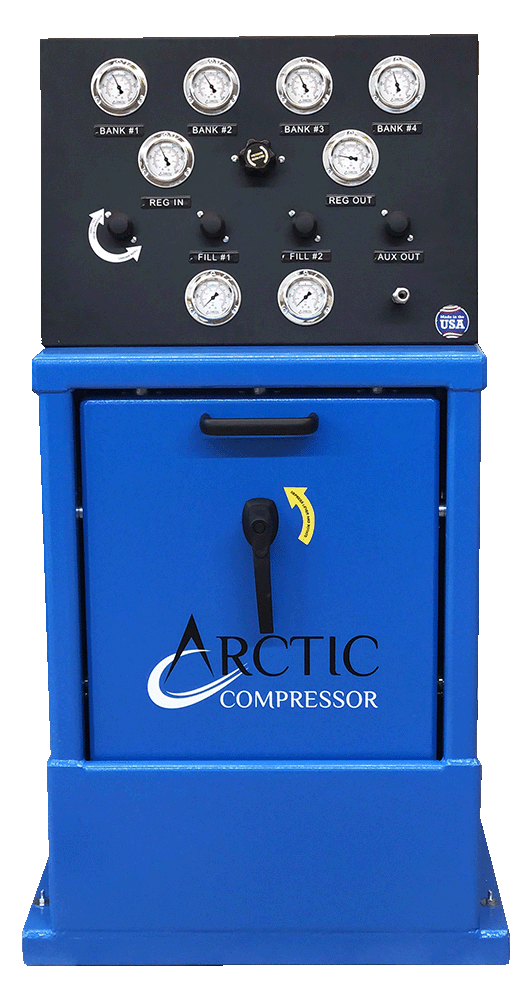
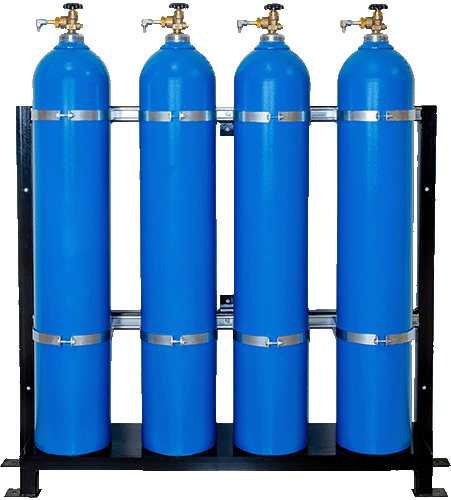
High-pressure breathing air compressors are used to compress ambient air through a multi-stage process to achieve the necessary high pressures, often as high as 6000 PSI. In addition to compression, the compressor aids in purifying the air, removing moisture, and filtering contaminants to ensure that the compressed air is clean and safe for use.
High-pressure air compressors and storage systems are typically designed to exceed the pressure requirements of the secondary tanks or canisters. This design principle accommodates the cascade filling method, which is commonly used in breathing air systems.
For example, Arctic Compressors are often rated at 6000 PSI, allowing for effortless filling of cylinders ranging from 2216 to 5500 PSI by simply adjusting the output pressure regulator. The size of all these components and the number of storage cylinders needed are commonly dictated by the needs of the department. Adding extra storage capacity can help lower the size and output requirements of the compressor, decreasing equipment and maintenance costs.
In most setups, fill stations are connected to a cascade storage system rather than directly to the compressor. The fill station is an important safety component of a breathing air system as they protect an operator filling SCBA cylinders in the event of a cylinder failure. This is achieved by directing the blast and any fragmented debris away from the operator. These fill stations usually feature an integrated cascade control panel for efficient operation. Similar to the compressor and storage cylinders, fill stations come in a variety of configurations to meet department needs allowing the operator to fill multiple air packs or even the option of upgrading to automatic cascade control panels to reduce the need for operator training and reducing user errors.
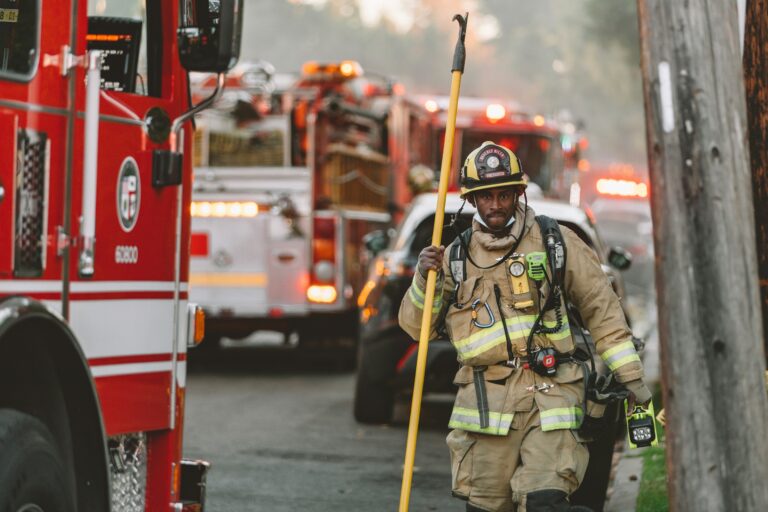
Several industrial and first responder occupations require the use of Self Contained Breathing Apparatus (SCBA) equipment to safely navigate environments that lack safe, breathable air. In many cases that require SCBA use, the ambient conditions can present respiratory hazards that pose long-term health risks and even death. These hazards often involve smoke, chemical contaminants, and pathogens, depending on the industry in question. Recreational and rescue divers use Self-Contained Underwater Breathing Apparatus (SCUBA), which have similar quality requirements but utilize different equipment.
The SCBA air packs used in the fire-safety and hazardous materials industries are available at 2216, 4500, and 5500 PSI. The 4500 and 5500 PSI SCBA cylinders are made of advanced materials, such as carbon fiber, which makes them more compact and lighter than the 2216 PSI cylinders. This leads many users to upgrade to higher-pressure equipment to gain the comfort and ease of movement afforded by less cumbersome equipment.
Arctic Compressors can commonly produce 5000 and 6000 PSI air for filling 3000 PSI SCUBA tanks used for diving and smaller, higher-pressure SCBA air packs.
Breathing air is compressed atmospheric air. Unlike Nitrox or other formulated air types, compressed breathing air is not enriched in any way. It is only purified atmospheric air. With the correct purification system breathing air can meet all the standards required for diving as well as firefighting and safety applications. The quality of compressed breathing air is highly dependent on the surroundings of the compressor or where the intake air comes from.
Industrial emissions, vehicle exhaust, combustion heating exhaust, chemicals, cleaners, and environmental conditions in the vicinity of an operating compressor can degrade the quality of intake air.
Compressor equipment issues, poor maintenance, and operational practices can also introduce contaminants into your SCBA air supply. Proper maintenance and routine quality testing are important components to keeping your personnel safe.
One of the most common causes of SCBA air quality failure is the presence of excessive moisture content. Moisture in breathing air can cause issues especially in low temperature environments and while diving. Proper air purification and filtration within the compressor are essential in helping to remove these contaminants.
The presence of high levels of moisture within the compressed air is a recurrent issue for SCBA breathing air in firefighting situations. Rapid environmental temperature changes for firefighting situations, both up and down, mandate that the SCBA air compressor must remove excess water during the compression process. System components can freeze, become clogged, or even damaged by air with unacceptable moisture. Excess moisture in breathing air combines with oil and solid contaminants to form sludge, which can clog or damage system components.


The Compressed Gas Association (CGA) and National Fire Protection Association (NFPA) have set strict standards for compressed breathing air to protect SCBA and SCUBA users from toxic gas, contaminants, and equipment failure due to high moisture content.
To ensure SCBA air quality, NFPA 1500 suggests a minimum CGA Grade D air quality.
CGA Grade E breathing air quality, required for SCUBA applications, is an improvement on CGA Grade D. With stricter regulations on acceptable moisture content, CGA Grade E allows for use in both SCBA and SCUBA applications. Because of this, many fire and dive rescue department programs have decided to use CGA Grade E as their minimum air standard as outlined in the quality standards set by NFPA 1989.
Yes, Arctic Compressor offers exceptional breathing air systems for many applications. There are several Arctic Compressor products to consider when evaluating breathing air systems, many of which offer the ability to customize to meet the specific needs of your department.
Compressors
Arctic Compressor offers several different configurations in our compressors, including our 2500 Series Enclosed Compressor, 1500 Series Enclosed Compressor, 1000 Series Enclosed Compressor, 1500 Series Open Frame Compressor, and 1000 Series Open Frame Compressor.
One of our most popular compressors is our 1500 Series Enclosed Compressor. This air compressor system is a 4-stage compressor with multiple motor options capable of delivering up to 14 CFM at 6000 PSI. It uses a dryer bed to remove water in excess of a dew point at -65 degrees Fahrenheit. The output air meets the NFPA 1500 standard, reducing the chance for moisture to create sludge or frozen equipment within the SCBA. The A1500 system is equipped with activated charcoal and a carbon monoxide catalyst to remove any organic contaminants and convert carbon monoxide, ensuring the highest air purity. An optional electronic carbon monoxide monitor provides continuous monitoring with audio and visual alarms. In the event of an alarm, the monitors shut down the attached compressor to safeguard your user’s health. With a standard filtration capacity of 24,000 cubic feet of air at 80 degrees Fahrenheit (expandable up to 57,000 cubic feet allowing you to extend the time between changing filters), the A1500 system is designed to meet the stringent standards of the CGA to provide CGA Grade E breathing air that you can count on.
Arctic Compressor’s fill stations are designed and certified to meet the rigorous standards set by the National Fire Protection Association (NFPA). Tested to withstand 5700 PSI burst pressure, our fill stations meet and exceed the NFPA 1901 (2016) 24.9.6.2 requirements of 5500 PSI. Our NFPA certification ensures that our fill stations meet or surpass the safety and performance requirements for fire apparatus and emergency response equipment, providing reliable and secure equipment for filling SCBA and SCUBA cylinders.
Arctic Compressor also offers the Arctic Auto-Cascade Control Panel, which can be paired with Arctic’s two or three-position fill station. The Arctic Auto-Cascade Panel is an innovative solution for efficiently managing compressed breathing air. This system automates the process of filling breathing air cylinders by pneumatically opening and closing storage banks as the pressure equalizes, maximizing the available stored air without requiring manual intervention or complex electronic systems.
The Arctic Auto-Cascade Control Panel increases operational efficiency and reduces the risk of human error. Its automatic operation also frees up personnel to focus on other critical tasks and is particularly valuable when refilling rescue truck air supplies. If you want a customized equipment package, give our staff a call so that we can design a system that fits your needs.
For specific fire and rescue department applications, it is important to consider several factors when considering the proper breathing air systems:
Arctic Compressor, LLC produces High-Pressure Air Compressors and Containment Fill Stations for use in the fire safety, industrial, and recreational markets. We have been designing and building high-pressure compressors for more than 30 years. If you are in the market for a new breathing air system or are looking to update your existing breathing air system, speak with one of our experts today!
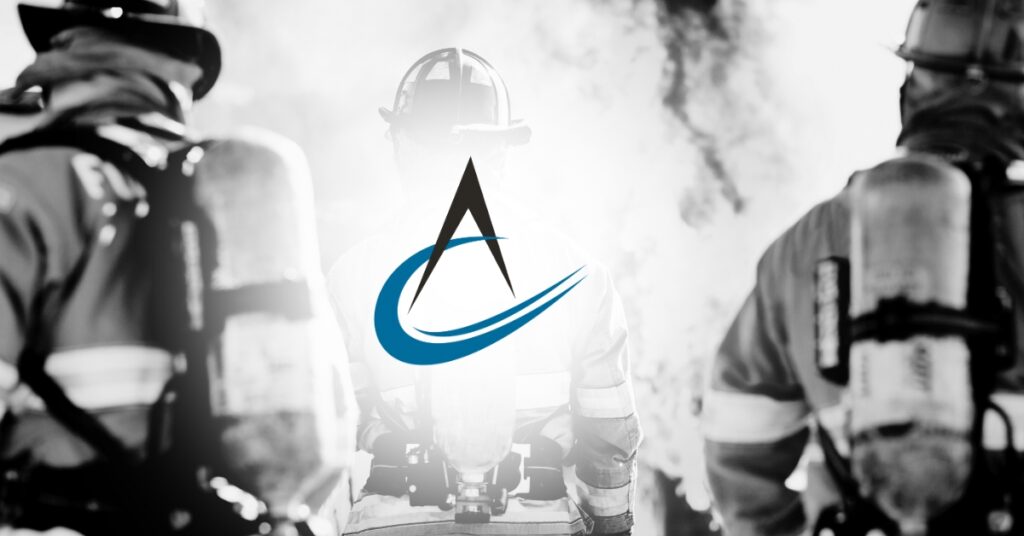
Arctic Compressor LLC produces High-Pressure Air compressors and Containment Fill Stations for use in the fire safety, industrial, and recreational markets. We have been designing and building high-pressure compressors for more than 30 years.
Phone:
Copyright 2025 – Arctic Compressor “The simple Choice”. All rights Reserved